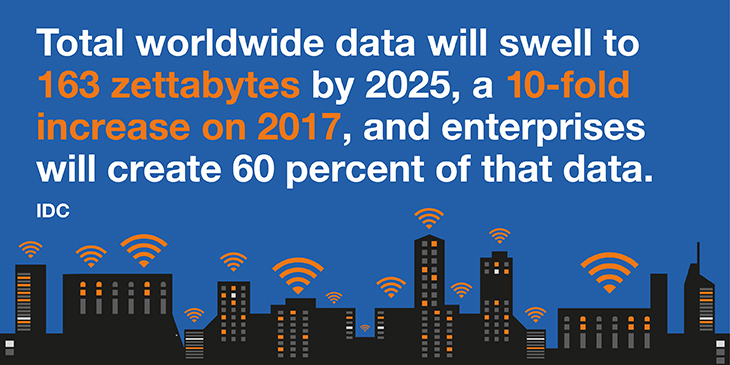It begins with a shift of mindset. Until fairly recently, data was an historic thing. You accumulated a fairly limited amount of data from your commercial activities over time, crunched it, analyzed it and extrapolated patterns manually to find ways to operate more efficiently.

So much has changed. The past few years have seen the data market explode as improvements in connectivity have helped enable real-time data flows from people, smartphones, work devices, cameras and the Internet of Things (IoT). Computing power has increased exponentially, dramatically speeding up the time it takes to run analytics processes, and data lakes make it easier to create a single store of all enterprise data, including raw copies of source system data, and have transformed data used for tasks such as reporting, visualization, analytics and machine learning. Data analysis, which previously might have taken 24 hours, can now be done in a matter of minutes. Businesses have recognized that data now means money. It’s an asset to be exploited.
Technology tools for leveraging data
This data tsunami is empowering new digital technologies – like machine learning (ML), natural language processing (NLP) and artificial intelligence (AI) – to turn data analysis from a reactive exercise into a proactive process that enables strategic business decision making and actions.
These technologies are powering the shift to the pre-emptive use of data, with data analysis tools now employing ML to greater degrees. ML is, in effect, a continuation of the concepts of predictive analytics, where assumptions are made about behavior based on historic patterns. Previously though, data analysis was limited by the high volumes of data available plus the time and cost constraints of human analysts.
In contrast, AI-enabled systems are able to assess and reassess data analysis models, make assumptions, test and learn autonomously without human intervention. As a result, cognitive systems are able to increase the frequency, flexibility and immediacy of data analysis. Done right, data analysis can bring huge value to a company in terms of efficiency, productivity, competitive advantage and cost savings – but you must have a plan in place to coordinate and exploit the data correctly to create insights.
How can you derive value from data?
To get the most out of your data, you need to approach it strategically. Consider these four approaches:
1. “Do new” This is about detecting where new sources of data may exist, taking that data and finding new insights or ways of doing business. For example, Business & Decision, an Orange Business company, has worked with a pharmaceutical company to trial analyzing bacterial growth in petri dishes using AI and image recognition. Doing this work manually is time-consuming and costly. AI quickly learns the patterns to enable high throughput screening and increase the accuracy of detection.
2. “Do better” You can take an existing operational process and use data to improve it and make it more efficient. Business & Decision worked with Port Antwerp to help address the problem of traffic congestion in the port. Data is gathered from ships heading to port to predict their arrival times. Advanced analytics are then employed to create congestion heatmaps and collision prevention plans and recognize the loading and unloading of shipping containers, enabling the port to monitor and act on congestion hotspots, better manage dock occupancy and pre-emptively avoid future traffic problems. It can also enable road transport companies in the logistics ecosystem to better plan their arrival times, saving them time and money.
3. “Do right” This approach refers to using data to anticipate risk, be it financial, security, regulatory, e-reputation or fraud. The Special Tax Inspectorate in Belgium had a problem with carousel fraud, a crime that costs an estimated €100 billion per year across Europe. Carousel fraud is a complex crime in which a party in one country sells goods to a second party in a tax-free country, who in turn sells the goods to a new buyer and collects the VAT, but does not declare it and give it to the government. The new buyer subsequently sells the goods tax-free and applies for a refund on the VAT the government didn’t receive originally. It is a high-return and hard-to-prove crime that exploits weaknesses in the VAT system.
Belgium’s Special Tax Inspectorate implemented an advanced data analytics solution that uses multiple analytical techniques to find fraudsters, saving the Belgian government almost €1 billion per year. Risk analysis is conducted using the advanced analytics to quickly identify suspect companies, and the Special Tax Inspectorate intervenes before major damage can be done.
4. “Do more” Enterprises are under pressure to enhance customer service levels by leveraging data. A global retail giant worked with Business & Decision to transform the customer’s experience of promotions with more personalized offers. Customers expect a more customized shopping event: according to Salesforce, 72 percent of consumers say they “expect companies to understand their unique needs and expectations.” With that in mind, the retailer shifted from mass marketing using aggressive promotions and price wars to gathering and analyzing loyalty-scheme data to design hyper-personalized, targeted messaging for its customers. The result was an increase in conversion rates of 70 percent.
These are solid examples of how to ensure that your data has a purpose. Better performance has a different meaning to different companies depending on their goals, and the four approaches outlined here are good strategies for addressing specific types of data for specific reasons in specific business sectors.
Companies that adopt a data-first philosophy to digital transformation, employ digital tools to connect disparate data sources, extract business-useful insights and make informed business decisions will be those that enjoy competitive advantage and future success.
Find out how to make data a strategy asset in your company.